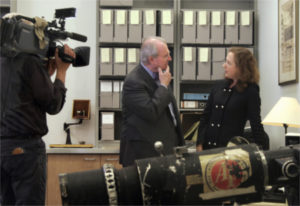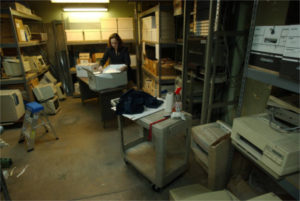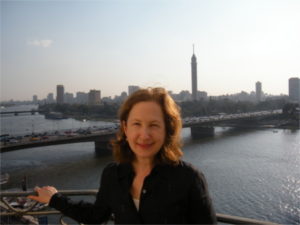Valerie Komor is the founding Director of the Associated Press Corporate Archives. Before joining AP in 2003, she held positions at the Oberlin College Archives, the Rockefeller Archive Center, the Smithsonian Institution Archives of American Art and the New-York Historical Society. She holds an M.A. in Medieval Studies from Yale University and an M.L.I.S. from the University of Texas at Austin. As a Fulbright scholar in Naples, Italy, she studied the writings of Matilde Serao, co-founder of Il Mattino, Naples’ daily paper.
Hometown: Los Angeles, CA.
Education: B.A., University of California, Davis; M.A., Yale University; M.L.I.S., University of Texas at Austin.
Languages Spoken: Latin, French, Italian.
What drew you to this line of work? I love “the stuff.” Even in the digital era, archival work requires working with personal papers, including letters, diaries, land deeds, wills, contracts, unpublished writings, photographs, keys, or calcified wedding cake. At AP, we preserve the personal papers of journalists as well as institutional records: charters and bylaws, minutes of the Board of Directors, legal and financial records, bureau records, administrative records, audio and video collections, artifacts, photographs and original wire copy.

First job as an archivist: Project Archivist, Oberlin College Archives, Oberlin, OH.
How did you come to work at the AP? In 2003, AP Vice President and Director of Corporate Communications, Kelly Tunney, asked me to establish AP’s first corporate archives. This offer was a great challenge, as it involved creating a new department and promoting a new idea within the company: the systematic documentation of AP itself.
Favorite item in the AP Archives: The Hudson Broadside: a very fancy “sympathy card” made in March 1866 for Frederick Hudson (1819-75), managing editor of The Herald newspaper and a member of the Executive Committee of the Associated Press. It is a large oval work on paper (40 in. high), hand-decorated in iron-gall ink with engraved vignettes and bordered by 18 salted paper portraits of the Committee members placed beneath their mastheads. Three portraits are by Mathew Brady.
Why is it important to have an archivist at a news organization? First, the AP Corporate Archives exists to document the organization for legal and business reasons. Second, the line between journalism and history is very fine. Archivists can ensure that when journalism becomes history, it is preserved. For example, on Nov. 22, 1963, every journalist knew they were witnessing and writing history of a transcendent order. AP journalists saved this copy and bound it, writing on the covers, “PRESERVE!” But journalists write history every day, and AP journalists may be said to write something preliminary to history: a factual accounting of events. When I came to AP, I sensed that the staff did not fully grasp the great scope and content of AP’s history. Journalists had been telling stories since 1846, but no one had told their story. I believe that archives make history real, and we do that here through research, exhibits, oral history, publications and special events.
 Major challenge in your current job: The preservation of the digital record in all of its formats, so that in 100 years, there will be a record of AP in the early 21st century. Unlike paper documents, which are readable by the naked eye, the contents of our laptops need our laptops to be legible. Thus, the preservation of 0s and 1s requires more resources than the preservation of paper. Left to itself, under good conditions, paper will last centuries.
Major challenge in your current job: The preservation of the digital record in all of its formats, so that in 100 years, there will be a record of AP in the early 21st century. Unlike paper documents, which are readable by the naked eye, the contents of our laptops need our laptops to be legible. Thus, the preservation of 0s and 1s requires more resources than the preservation of paper. Left to itself, under good conditions, paper will last centuries.
Year you joined the OPC: 2014.
When traveling, you like to … Walk a lot, see the art and architecture, and eat.
Favorite quote: From Wallace Stevens’ “Esthetique du Mal”: “The greatest poverty is not to live in a physical world.”
Place you’re most eager to visit: Thomas Hardy’s home at Max Gate in Swindon, England.
Place I would like to return to: Capri.

